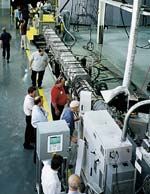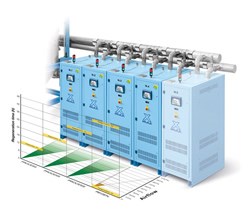New Approach to PET Drying To Debut This Fall at K 2010 Show
An Italian maker of auxiliary equipment has come up with a new system that combines several unusual concepts to make high-volume PET drying faster and more consistent with lower energy use.
An Italian maker of auxiliary equipment has come up with a new system that combines several unusual concepts to make high-volume PET drying faster and more consistent with lower energy use. Moretto S.p.A. in Massanzago (moretto.com) designed the new X Max drying system to accommodate increasing throughputs of PET preforms as numbers of mold cavities keep increasing. Company founder and president Renato Moretto says uncertain economic conditions require that such a large system also offer flexibility—allowing lower throughputs without sacrificing efficiency, as well as changes in the mix of preform sizes and weights. Moretto also notes that X Max is designed to clamp down on PET molders’ second largest cost after raw material—energy, at least 30% of which is consumed in drying. In addressing all of these goals, Moretto believes he has identified and corrected some of the limitations of most existing systems. He also has an unusual no-risk plan to encourage molders to try out this new technology. Moretto plans to introduce several new technologies, which he calls the Eureka project, at the K 2010 show in Dusseldorf in late October.
CONSTANT DRYING PERFORMANCE
The Eureka project combines the new dryer and Flowmatik controller with a new OTX hopper to be unveiled at K 2010. The high-volume system can incorporate three to 10 dryers and up to 32 hoppers to permit throughputs up to 8000 kg/hr. One key to the system is the X Max dryer. Unlike the typical twin-bed/twin-tower design, X Max has a single desiccant bed, which is 50% larger than a standard bed and doesn’t use any compressed air or cooling water. In a multi-dryer system, each dryer would be set at the same temperature and airflow rate, but at a staggered arrangement of different dewpoints. Each dryer has a standalone air circuit and is controlled by a dewpoint meter. Thanks to their different dewpoint settings, the dryers will not need regenerating at the same time, and the Flowmatik controller manages the sequence so that the mix of process air from the dryers maintains a constant value around -65 C/-85 F. One dryer can be taken off line, and a freshly regenerated spare dryer (standard in the system) can be brought on to replace it. One goal of the multi-tower system is to maintain more consistent dewpoint throughout the process cycle than with other systems.
Another aspect of the system is common to Moretto’s twin-tower X Dryer line, introduced in 2003. The desiccant bed consists of metal tubes filled with desiccant and an airflow channel in the center with a heater in the center of the channel. This is said to provide more uniform heating and efficient regeneration with lower airflow, thereby saving considerable energy. Inside the circuit is a heat exchanger, which is said to allow complete recovery of regeneration energy.
Each hopper has its own heater, airflow valve, and flowmeter. Large sizes of 1000 to 10,000 liters are planned for this high-volume system. A novel option, available on these and other Moretto hoppers, allows them to open from the bottom with pneumatic assist, rather than from the top, for enhanced worker safety.
Just as important as the dryer is the Flowmatik controller, introduced four years ago and integrated into the system. The Flowmatik central controller is programmed to know each hopper’s capacity and the material’s bulk density, desired residence time, temperature, and airflow rate. “You only have to enter the material type and desired throughput rate,” says Moretto, “and the system takes care of the rest.” Moretto notes that the ability to tailor airflow to the throughput rate produces bigger savings at reduced throughput rates. Moretto guarantees that the Flowmatik system can provide return on investment in only two years from the energy savings alone.
He says still greater savings may be possible with his idea for a Flowmatik Multi Split system. It splits the PET to be dried between a first, larger hopper at a relatively low drying temperature and a second, smaller hopper at the typical 180 C/356 F drying temperature. Moretto says this more efficient system could reduce airflow needs by more than half.
RETHINKING HOPPER DESIGN
The combination of the X Max dryer and Flowmatik controller was recently introduced to the PET market as the Flowmax system. Even greater energy savings are predicted for the Eureka project, which will incorporate the completely new OTX hopper design. Moretto used computerized fluid-dynamic and thermodynamic simulations to analyze current leading drying-hopper designs. The analysis identified nonuniform flow through the hoppers as well as temperature gradients of up to 80° C/144° F from the center to the outside. The result is that despite a nominal 4-hr residence time in the hopper, some material exits the hopper in as little as 2.5 hr, and that material can contain twice as moisture as the average for the hopper as a whole.
Moretto redesigned its hopper with a larger central torpedo and with drying air introduced from the circumference of the bed, rather than the center. Some of that is injected air higher up the hopper than usual. After two years of testing, the results, according to Moretto, are no radial temperature gradient in the hopper and much more uniform time of travel through the hopper. “Unlike the uncontrolled mixing that occurs in normal hoppers, we get much more uniform moisture ppm over time. You can establish the exact drying time needed once you have control over the process,” Moretto claims. He says this increased ppm control and uniformity means that drying time can be reduced to 4 hr from the typical 6 hr; drying temperatures can be cut from 180 C/356 F down to 175 C/347 F; and airflow can be trimmed up to 40%—all while achieving 30 ppm final moisture. With this new OTX hopper, Moretto predicts a 30% reduction in drying time, 40% reduction in airflow requirement, and 25% reduction in hopper volume needed for the same throughput.
Moretto is so confident of the savings to be offered by his new system that he will use them as a way to encourage molders to adopt this new technology at little or no financial risk. He will offer to install the Eureka system at no upfront cost and will charge a monthly fee based on the predicted energy savings and the customer’s energy costs. After two years, the customer will have paid for the system only with energy savings and will then own it. If not satisfied, the customer can return the system at no additional cost.
Moretto is very interested in the U.S. market. Until a U.S. agent has been found and trained, Mr. Moretto himself is directing the Eureka project, supported by a special sales team.
Related Content
Three Key Decisions for an Optimal Ejection System
When determining the best ejection option for a tool, molders must consider the ejector’s surface area, location and style.
Read MoreProcess Monitoring or Production Monitoring—Why Not Both?
Molders looking to both monitor an injection molding process effectively and manage production can definitely do both with tools available today, but the question is how best to tackle these twin challenges.
Read MoreWhat to Look for in High-Speed Automation for Pipette Production
Automation is a must-have for molders of pipettes. Make sure your supplier provides assurances of throughput and output, manpower utilization, floor space consumption and payback period.
Read MoreKnow Your Options in Injection Machine Nozzles
Improvements in nozzle design in recent years overcome some of the limitations of previous filter, mixing, and shut-off nozzles.
Read MoreRead Next
Beyond Prototypes: 8 Ways the Plastics Industry Is Using 3D Printing
Plastics processors are finding applications for 3D printing around the plant and across the supply chain. Here are 8 examples to look for at NPE2024.
Read MoreLead the Conversation, Change the Conversation
Coverage of single-use plastics can be both misleading and demoralizing. Here are 10 tips for changing the perception of the plastics industry at your company and in your community.
Read More






















